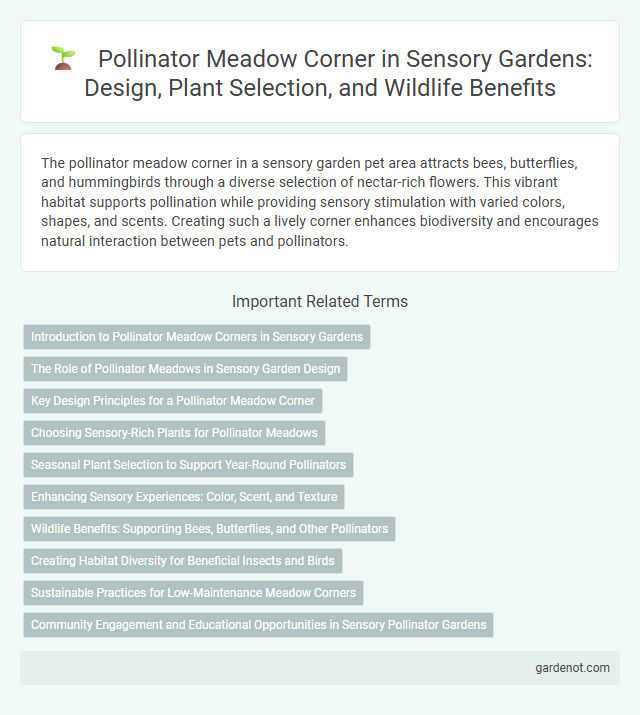The pollinator meadow corner in a sensory garden pet area attracts bees, butterflies, and hummingbirds through a diverse selection of nectar-rich flowers. This vibrant habitat supports pollination while providing sensory stimulation with varied colors, shapes, and scents. Creating such a lively corner enhances biodiversity and encourages natural interaction between pets and pollinators.
Introduction to Pollinator Meadow Corners in Sensory Gardens
Pollinator meadow corners in sensory gardens create vibrant habitats that attract bees, butterflies, and other vital pollinators essential for ecosystem health. These areas feature fragrant, nectar-rich flowers like lavender, coneflowers, and milkweed that stimulate sensory engagement through sight, smell, and touch. Integrating diverse native plants supports pollinator populations while enhancing educational and therapeutic experiences within sensory garden spaces.
The Role of Pollinator Meadows in Sensory Garden Design
Pollinator meadows play a crucial role in sensory garden design by attracting diverse pollinators such as bees, butterflies, and hummingbirds, enhancing biodiversity and ecological balance. These meadows provide vibrant colors, varied textures, and dynamic scents that stimulate sensory experiences, promoting engagement and education about pollination processes. Incorporating native flowering plants in pollinator meadow corners supports local ecosystems, improves garden sustainability, and creates a habitat-rich environment for sensory exploration.
Key Design Principles for a Pollinator Meadow Corner
A pollinator meadow corner thrives by prioritizing native flowering plants that bloom sequentially from early spring to late fall, ensuring continuous nectar and pollen sources. Incorporating diverse plant species with varying heights and flower shapes attracts a wide range of pollinators, including bees, butterflies, and hummingbirds, enhancing biodiversity. Soil health is maintained through organic mulch and minimal disturbance, creating a sustainable environment that supports pollinator nesting and larval development.
Choosing Sensory-Rich Plants for Pollinator Meadows
Selecting sensory-rich plants for a pollinator meadow corner enhances biodiversity and supports essential pollinator species like bees, butterflies, and hummingbirds. Incorporate native flowering plants such as milkweed, coneflowers, and goldenrod for vibrant colors, varied textures, and enticing fragrances that stimulate multiple senses. Prioritize a mix of bloom times and plant heights to create continuous visual interest and provide diverse habitats for pollinators throughout the growing season.
Seasonal Plant Selection to Support Year-Round Pollinators
Seasonal plant selection in the pollinator meadow corner is crucial for providing continuous nectar and pollen sources throughout the year, supporting diverse pollinator populations such as bees, butterflies, and hummingbirds. Incorporating native wildflowers like coneflowers, asters, and goldenrod enhances habitat suitability by attracting specific pollinators during spring, summer, and fall. Strategic planting ensures ecological balance, promotes pollinator health, and sustains biodiversity within the sensory garden ecosystem year-round.
Enhancing Sensory Experiences: Color, Scent, and Texture
The pollinator meadow corner in a sensory garden enriches sensory experiences by offering a vibrant palette of colors from diverse flowering plants that attract bees, butterflies, and hummingbirds. Fragrant blooms release natural scents that stimulate olfactory senses, while varied leaf textures provide tactile engagement for visitors. This combination supports pollination while creating an immersive environment that fosters connection with nature through multiple sensory channels.
Wildlife Benefits: Supporting Bees, Butterflies, and Other Pollinators
A pollinator meadow corner enhances biodiversity by providing essential habitats and nectar sources for bees, butterflies, and other pollinators. Native wildflowers and plants attract and sustain these species, contributing to improved pollination and ecosystem health. Supporting pollinator populations also promotes fruit and seed production vital for local wildlife.
Creating Habitat Diversity for Beneficial Insects and Birds
Pollinator meadow corners enrich sensory gardens by fostering habitat diversity essential for beneficial insects and birds. Native wildflowers, grasses, and flowering shrubs provide continuous nectar, pollen sources, and shelter throughout the seasons. Incorporating varied plant heights and structures boosts species richness, supports pollinator populations, and enhances ecological balance within the garden.
Sustainable Practices for Low-Maintenance Meadow Corners
Pollinator meadow corners thrive through sustainable practices such as using native plant species, which require minimal watering and fertilizer, promoting biodiversity and ecosystem health. Incorporating perennial wildflowers enhances soil stability and reduces erosion, ensuring long-term meadow vitality with little maintenance. Regular seasonal mowing prevents invasive species spread and encourages robust pollinator populations by maintaining diverse floral resources.
Community Engagement and Educational Opportunities in Sensory Pollinator Gardens
Pollinator meadow corners in sensory gardens foster community engagement by inviting local residents to participate in planting and maintaining diverse native plants that attract bees, butterflies, and other pollinators. These spaces serve as dynamic educational opportunities where visitors can learn about pollinator behavior, plant-pollinator relationships, and the ecological importance of biodiversity through interactive workshops and guided tours. Community involvement in such gardens enhances environmental stewardship and promotes awareness of sustainable gardening practices crucial for pollinator conservation.
Pollinator meadow corner Infographic

 gardenot.com
gardenot.com